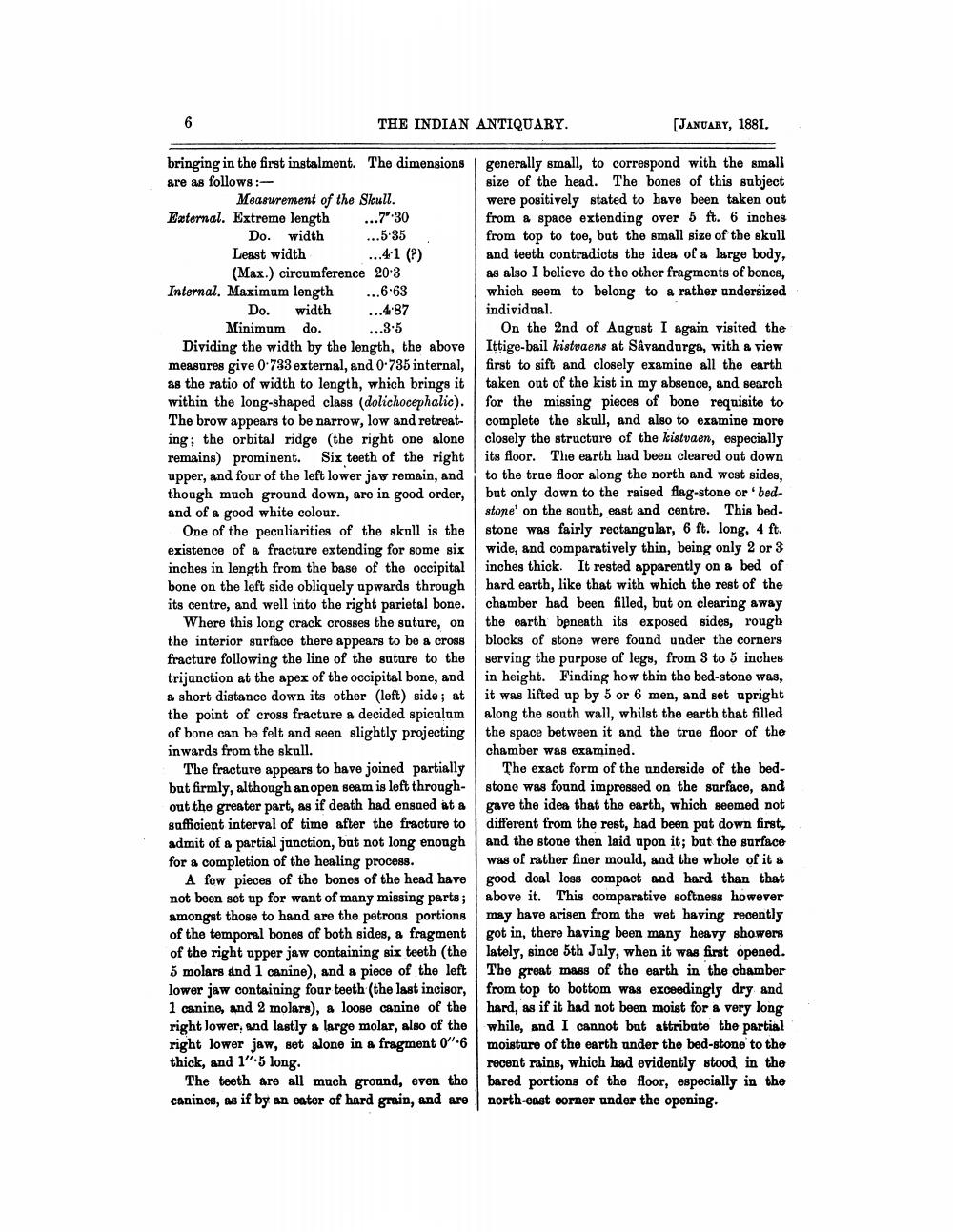________________
THE INDIAN ANTIQUARY.
(JANUARY, 1881.
bringing in the first instalment. The dimensions are as follows:
Measurement of the Skull. External. Extreme length ...7.30
Do. width ...5-35 Least width ...4:1 (?)
(Max.) circumference 203 Internal. Maximum length ...6.63
Do. width ...4.87
Minimum do. ...3.5 Dividing the width by the length, the above measures give 0 733 external, and 0-735 internal, as the ratio of width to length, which brings it within the long-shaped class (dolichocephalic). The brow appears to be narrow, low and retreating; the orbital ridge (the right one alone remains) prominent. Six teeth of the right upper, and four of the left lower jaw remain, and though much ground down, are in good order, and of a good white colour.
One of the peculiarities of the skull is the existence of a fracture extending for some six inches in length from the base of the occipital bone on the left side obliquely upwards through its centre, and well into the right parietal bone.
Where this long crack crosses the sature, on the interior surface there appears to be a cross fracture following the line of the suture to the trijunction at the apex of the occipital bone, and a short distance down its other (left) side; at the point of cross fracture a decided spiculum of bone can be felt and seen slightly projecting inwards from the skull.
The fracture appears to have joined partially but firmly, although an open seam is left through- out the greater part, as if death had ensued at a sufficient interval of time after the fracture to admit of a partial junction, but not long enough for a completion of the healing process.
A few pieces of the bones of the head have not been set up for want of many missing parts; amongst those to hand are the petrous portions of the temporal bones of both sides, a fragment of the right upper jaw containing six teeth (the 5 molars and 1 canine), and a piece of the left lower jaw containing four teeth (the last incisor, 1 canine, and 2 molars), a loose canine of the right lower, and lastly a large molar, also of the right lower jaw, set alone in a fragment 0:6 thick, and 1" 5 long.
The teeth are all much ground, even the canines, as if by an eater of hard grain, and are
generally small, to correspond with the small size of the head. The bones of this subject were positively stated to have been taken out from a space extending over 5 ft. 6 inches from top to toe, but the small size of the skull and teeth contradicts the idea of a large body, as also I believe do the other fragments of bones, which seem to belong to a rather undersized individual
On the 2nd of Angust I again visited the Ittige-bail kistvaens at Savandurga, with a view first to sift and closely examine all the earth taken out of the kist in my absence, and search for the missing pieces of bone requisite to complete the skull, and also to examine more closely the structure of the kistvaen, especially its floor. The earth had been cleared out down to the true floor along the north and west sides, but only down to the raised flag-stone or bodstone' on the south, east and centre. This bedstone was fairly rectangular, 6 ft. long, 4 ft. wide, and comparatively thin, being only 2 or 3 inches thick. It rested apparently on a bed of hard earth, like that with which the rest of the chamber had been filled, but on clearing away the earth beneath its exposed sides, rough blocks of stone were found under the corners serving the purpose of legs, from 3 to 5 inches in height. Finding how thin the bed-stone was, it was lifted up by 5 or 6 men, and set upright along the south wall, whilst the earth that filled the space between it and the true floor of the chamber was examined.
The exact form of the underside of the bedstone was found impressed on the surface, and gave the idea that the earth, which seemed not different from the rest, had been pat down first, and the stone then laid upon it; but the surface was of rather finer mould, and the whole of it a good deal less compact and hard than that above it. This comparative softness however may have arisen from the wet having recently got in, there having been many heavy showers lately, since 5th July, when it was first opened. The great mass of the earth in the chamber from top to bottom was exceedingly dry and hard, as if it had not been moist for a very long while, and I cannot bat attribute the partial moisture of the earth under the bed-stone to the recent rains, which had evidently stood in the bared portions of the floor, especially in the north-east corner under the opening.




